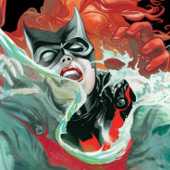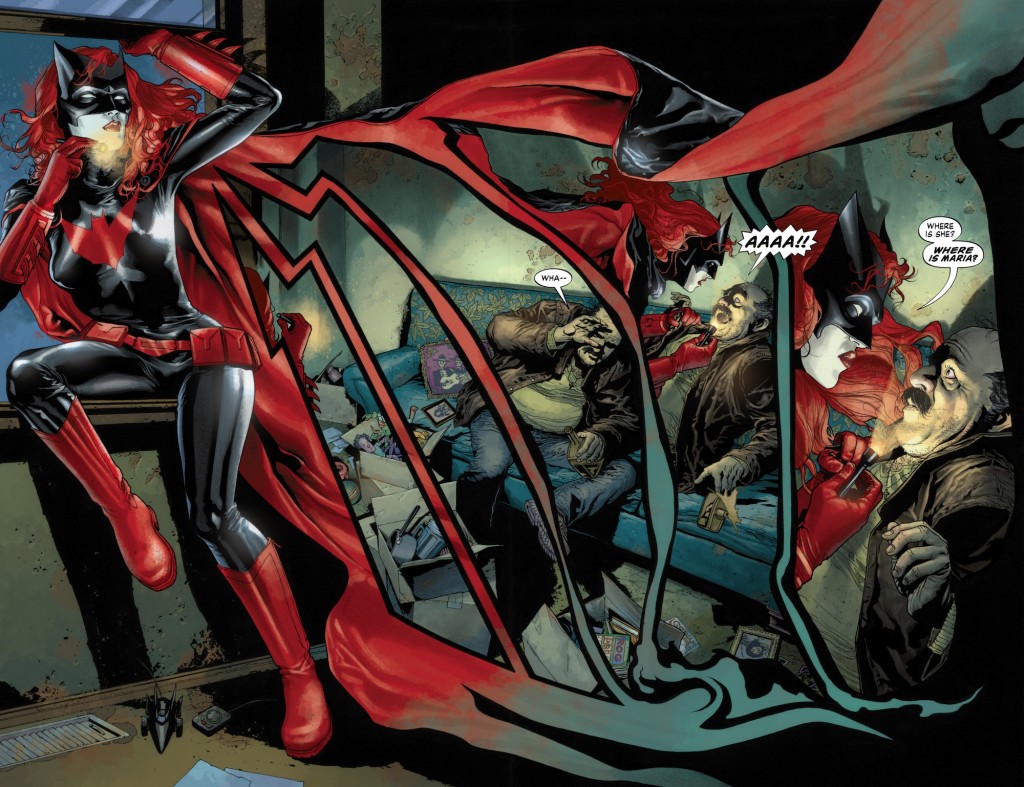Thrills Rip Forth
Reviews of BATWOMAN VOL. 1: HYDROLOGY and EMPOWERED VOL. 7
Superheroines rule the day as we look at two of comics’ most fearsome femme fatales…well, one of them at least — Emp is getting there. Specters, spooks, and the screams of missing children haunt Batwoman, Kate Kane, in her New 52 solo series. Meanwhile, the continuing adventures of Empowered give pause for Emp’s best friend Ninjette, fearsome ninja princess from New Jersey, to take center stage, squaring off against a squad of rival ninja, her reproductive rights as the ultimate stake.
Batwoman Vol. 1: Hydrology
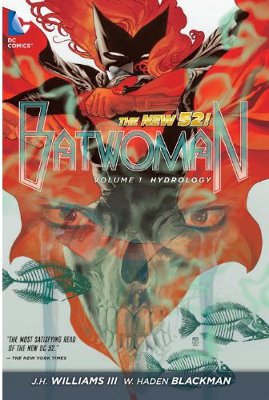 Born out of the pages of 52 and codified in her own lauded Detective Comics arc, Batwoman: Elegy, Kate Kane, the latest heroine to bear the Batwoman moniker, proved immensely popular due in no small part to the writing of Greg Rucka. Taking inspiration from the real life story of Dan Choi, Rucka crafted a character out of the most basic of superheroic elements: inspired by personal tragedy, a person with the drive and the ethos to serve a greater cause than themselves takes up the mantle of the Bat to fight crime. In Kate Kane’s case, a cadet in the USMA at West Point, daughter of a U.S. Army colonel, is ejected from the academy for violation of then-current Don’t Ask, Don’t Tell policy. Ever the restless soldier, unwilling to live a life without service, inspired by local Gotham hero Batman, Kane assumes the title of Batwoman and joins the caped crusader’s mission to extinguish Gotham’s corruption.
Born out of the pages of 52 and codified in her own lauded Detective Comics arc, Batwoman: Elegy, Kate Kane, the latest heroine to bear the Batwoman moniker, proved immensely popular due in no small part to the writing of Greg Rucka. Taking inspiration from the real life story of Dan Choi, Rucka crafted a character out of the most basic of superheroic elements: inspired by personal tragedy, a person with the drive and the ethos to serve a greater cause than themselves takes up the mantle of the Bat to fight crime. In Kate Kane’s case, a cadet in the USMA at West Point, daughter of a U.S. Army colonel, is ejected from the academy for violation of then-current Don’t Ask, Don’t Tell policy. Ever the restless soldier, unwilling to live a life without service, inspired by local Gotham hero Batman, Kane assumes the title of Batwoman and joins the caped crusader’s mission to extinguish Gotham’s corruption.
But with the departure of Greg Rucka from DC for Marvel, the pertinent question here becomes, can Batwoman maintain the same level of quality established in Elegy without Rucka’s penmanship? In his place, artist J.H. Williams III has stepped up to fill Rucka’s shoes with help from W. Haden Blackman, and, together, they keep the momentum going.
Hydrology continues the story of Batwoman where Elegy concluded, Kane investigating the disappearances of children from Gotham’s Hispanic neighborhoods while still recovering from the revelation of her father’s lies and the apparent death of Alice, Elegy’s villainess. Complications emerge with the arrival of Kate’s cousin Bette Kane, alias Flamebird, former Teen Titan, who Kane takes under her wing to train as a sidekick. More complications arise as a new criminal organization, Medusa, infiltrates Gotham (oh, good, as if Gotham didn’t have enough of those already). Yet more complications surface when the Department of Extranormal Operations (DEO)’s director takes a particular interest in Batwoman…and discovering the face beneath the mask.
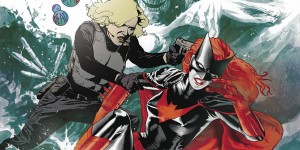 Normally, I don’t spare quite as many words for a book’s artwork as I do for its writing — not for a lack of appreciation, mind, but more for my story-oriented approach to most art. But here it’s nearly impossible to separate story from visuals, as is true of nearly everything J.H. Williams III touches. His images could drive even the weakest plots, but thankfully Williams and Blackman weave a compelling tale driven by Kate’s mentoring of Bette, budding relationship with Detective Sawyer, and collapsing ties to her father.
Normally, I don’t spare quite as many words for a book’s artwork as I do for its writing — not for a lack of appreciation, mind, but more for my story-oriented approach to most art. But here it’s nearly impossible to separate story from visuals, as is true of nearly everything J.H. Williams III touches. His images could drive even the weakest plots, but thankfully Williams and Blackman weave a compelling tale driven by Kate’s mentoring of Bette, budding relationship with Detective Sawyer, and collapsing ties to her father.
It’s a bit much to balance all at once but our writers give adequate attention to main and secondary characters alike. However, this dedication to character comes at the cost of trimming the primary plotline down to a sliver. Surprisingly little time is dedicated to Gotham’s missing Hispanic children despite clearly occupying a large share of Batwoman’s mind. But the plot never runs too thin, thankfully; we get just enough, just not as much as we would like. Our main antagonist gets the least character development of all, thus the eventual climax lacks the investment gained from a more fleshed out villain.
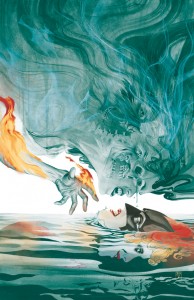 Inevitably, this six issue volume consumes itself mostly in setup for future issues — a problem perhaps remedied best by introducing Director Bones and Cameron Chase at book’s end, teasing them for future issues while dedicating more time to Kate and Bette’s teamwork investigating the missing children and Medusa. As is, Bones and Chase, of the book’s hefty stable of secondary characters, contribute the least to the book’s overall plot (which pains me to say because I love Director Bones and his lovable bastard characterization here).
Inevitably, this six issue volume consumes itself mostly in setup for future issues — a problem perhaps remedied best by introducing Director Bones and Cameron Chase at book’s end, teasing them for future issues while dedicating more time to Kate and Bette’s teamwork investigating the missing children and Medusa. As is, Bones and Chase, of the book’s hefty stable of secondary characters, contribute the least to the book’s overall plot (which pains me to say because I love Director Bones and his lovable bastard characterization here).
All the while, Williams assembles panels like panes in a stained glass window, each image assembled into a vibrant suite, demonstrated best in his two-page spreads, like Detective Sawyer’s investigation of metahuman massacre and yet another of Williams’ favored bat-symbol arrangements.
Each character’s narrative voice shapes the images around them: observations form zooms and x-rays, psychoses swirl and warp borders, and moods determine style from Kate’s clean, classically rendered life unmasked to Batwoman’s dark, realistic mode suffused with elaborate, slick, and grimy shades and complex panels. Colorist Dave Stewart adds wondrous layers to Williams’ already phenomenal pencils. From every angle imaginable, Batwoman leads the pack in artistic merits, embarrassing all other books achieving less. You won’t find a more gorgeous volume on the market from DC or any other publisher.
The combination of a great character and superlative artist subdue whatever minor narrative hiccups that arise in this volume. In the end, you’ll be yearning for more: more Batwoman, more adventure, more J.H. Williams making sweet, sweet love to your retinas. Unquestionably, for any fan of Batman or Bat-Family characters — hell, any fan of superheroes or sequential art — this is a must-read.
Empowered Vol. 7
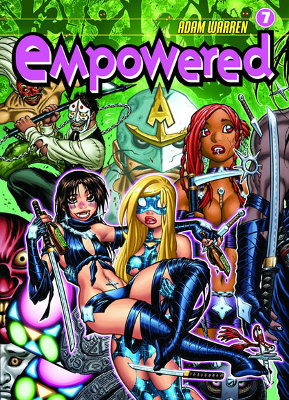 Sexy fun times return with a heaping dose of ninja in the ongoing adventures of a girl and her superpowered long underwear.
Sexy fun times return with a heaping dose of ninja in the ongoing adventures of a girl and her superpowered long underwear.
I love Empowered. It’s possibly one of my favorite comic books, certainly the one I look forward to most whenever I hear a new volume is on its way. In fact, Empowered holds a special place in my heart because it helped bridge the gap between my lifelong manga fandom and mainstream comic books. It seemed to fit in with that exceptional form of comic like Kick-Ass or Watchmen which comment more on the style and form of comic books rather than conforming to them. What surprised me was how the book, rather than subvert or reject typical cliches of the genre, embraced them, making them a part of the book’s fictional culture. Your usual damsel-in-distress in Empowered’s world is not merely the over-abused trope we know it as but a subculture, complete with its own set of standards, mores, slang, and even sub-cliches.
Classifying Empowered as a satire, as most are prone to do, seems somewhat inappropriate if for no other reason than it avoids descending into the gross negativism and cynical pessimism consuming other comic book “satires” like Preacher or The Boys (or anything by Garth Ennis, for that matter). It strikes me more as an affectionate parody, poking fun at superhero tropes without condemning them outright, akin to The Venture Bros. Moreover, Empowered manages to remain consistently fun and entertaining with no pretense about making broader statements or declarations as you might see in other books striving for the subversive and meta. Ironically, by focusing on the characters and their own self-conscious quirks, a book about tights-wearing superhumans and villains with giant punctuation marks on their heads seems more down-to-earth and packed with universal messages about human nature, vigilantism, and the potential for coexistence between superhumans (or “suprahumans” per Empowered terminology) and normal humans than most books foisted under the “dark and edgy” banner.
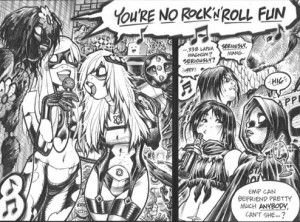 Oh, yeah, and then there’s the sex appeal. Probably the thing Empowered is most known for. After all, the title character has her origins in a series of commissions for damsel-in-distress bondage art (believe me, she’s come a long way since then…a long, long way). And volume seven continues that fine tradition with plenty of near-nudity, nipple pasties, baudy discussions of superhero sex habits, and Emp’s signature, leave-nothing-to-the-imagination supersuit. (And yet f-bombs and other familiar four letter words still get censored for some reason despite the book’s obviously M-rated content.)
Oh, yeah, and then there’s the sex appeal. Probably the thing Empowered is most known for. After all, the title character has her origins in a series of commissions for damsel-in-distress bondage art (believe me, she’s come a long way since then…a long, long way). And volume seven continues that fine tradition with plenty of near-nudity, nipple pasties, baudy discussions of superhero sex habits, and Emp’s signature, leave-nothing-to-the-imagination supersuit. (And yet f-bombs and other familiar four letter words still get censored for some reason despite the book’s obviously M-rated content.)
For the seventh volume of the series, we pause our leading lady’s ongoing plotlines to focus on supporting character Ninjette, kickass ninja princess from New Jersey. Per multinational ninja clan tradition, clan royalty, princesses especially, serve key roles in keeping the clans alive via arranged marriages — though this carries with it the unfortunate implication of turning young girls into little more than breeding stock for the…less bountiful ninja clans — a prospect with which Ninjette is none too keen. Having bested Ninjette in previous volumes only to be curbstomped by Emp, the Ayakami ninja clan return to settle the score by capturing Ninjette, horribly mutilating her, and sending her back to her clan to meet her fate, only this time ‘Jette is ready with a surprise counterattack of her own.
At first, the sudden change of focus away from our title character seems like a gyp. After all, these books aren’t exactly released month-to-month — the next time we see these characters may be a year and a half to two years away — so dangling plot threads keep a-dangling, wrapping up only ‘Jette’s ninja clan rivalry chicaneries. But this volume serves a different overall narrative purpose.
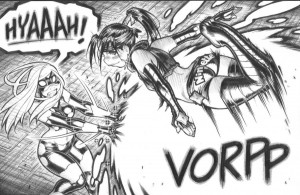 Warren’s typical brand of satire and humor are in full force here, as well as the sudden dramatic shifts common in later volumes, but overall volume seven feels lighter than volume six: it’s a breather episode, a chance for the characters to recover from the events of volume six, distance themselves from the tragedies, and regain some measure of sanity. While ‘Jette’s conflict takes center stage, flashbacks recount the fallout of Death Monger’s siege and we get plenty of our leading lady as well as all our favorite secondary characters (though not enough Strapping Buck, who deserves his own spin-off, in my humble opinion…He’s a dear that walks like a man and has super strength! And his name is Strapping Buck! You can’t tell me that’s not awesome! FEAR THE DEER!). Taking some pressure off Empowered gives us a buffer for the dark waters alluded to in Vol. 7’s final pages: mainly, the return of Willie Pete and revelations of Thugboy’s past finally coming to light.
Warren’s typical brand of satire and humor are in full force here, as well as the sudden dramatic shifts common in later volumes, but overall volume seven feels lighter than volume six: it’s a breather episode, a chance for the characters to recover from the events of volume six, distance themselves from the tragedies, and regain some measure of sanity. While ‘Jette’s conflict takes center stage, flashbacks recount the fallout of Death Monger’s siege and we get plenty of our leading lady as well as all our favorite secondary characters (though not enough Strapping Buck, who deserves his own spin-off, in my humble opinion…He’s a dear that walks like a man and has super strength! And his name is Strapping Buck! You can’t tell me that’s not awesome! FEAR THE DEER!). Taking some pressure off Empowered gives us a buffer for the dark waters alluded to in Vol. 7’s final pages: mainly, the return of Willie Pete and revelations of Thugboy’s past finally coming to light.
Warren’s pencil work remains excellent, improved by the switch from pulp to glossy pages. The higher contrast removes the dinginess from the shading and makes each panel look less muddled and over-detailed, problems repeatedly plaguing previous Empowered volumes. As well, Warren finds a superior balance for his typically verbose dialogue. Dialogue balloons no longer crowd out panels and the Caged Demonwolf’s speech has been toned down to just the right level, just enough so he never tips over into the obnoxious (an unfortunately common occurrence in previous volumes). 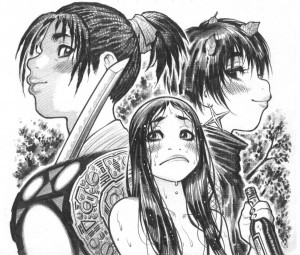 Warren’s balance of drama and humor also improves with each volume with Vol. 7 nimbley mixing the dark, the comic, and the darkly comic: karaoke night with zombie superheroes, ‘Jette’s tragic recollections of her father, Emp’s continued bumbling attempts to understand her supersuit’s capabilities, all work to make you care for these misfits characters and their parodic romps.
Warren’s balance of drama and humor also improves with each volume with Vol. 7 nimbley mixing the dark, the comic, and the darkly comic: karaoke night with zombie superheroes, ‘Jette’s tragic recollections of her father, Emp’s continued bumbling attempts to understand her supersuit’s capabilities, all work to make you care for these misfits characters and their parodic romps.
If you’re not into this series yet, pick up the first volume and give it a go. You’ll find a smart, humorous book filled with compelling, lovable characters and crackin’ good jabs at superhero-dom. If you’ve read the past six volumes already, what are you waiting for? Seven brings the same magic and humor, a lighthearted prelude to the foreboding shadows hinted at for volume eight.

